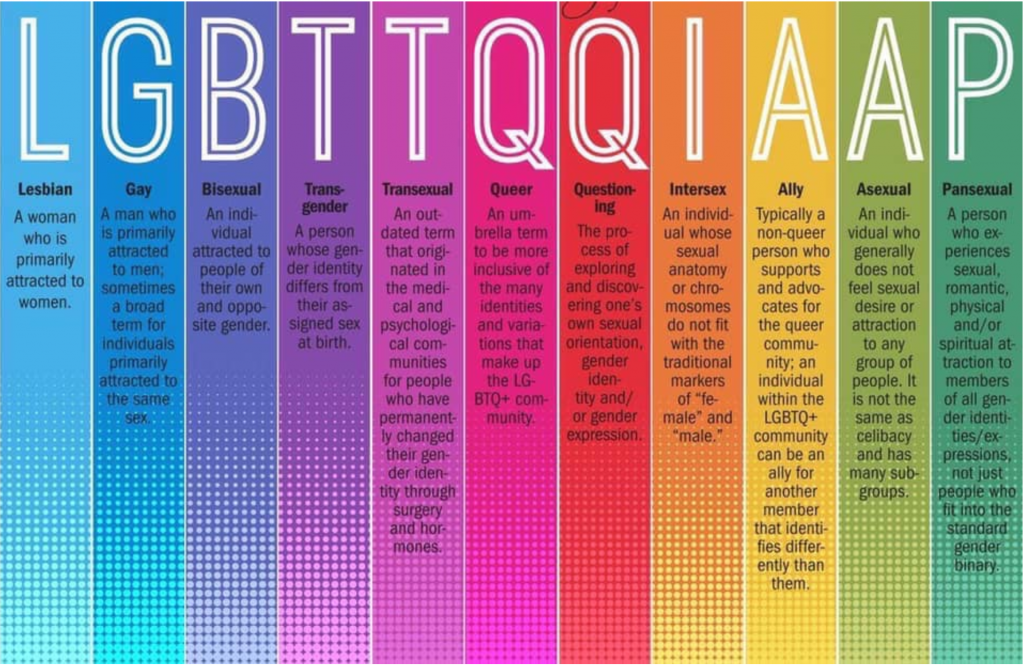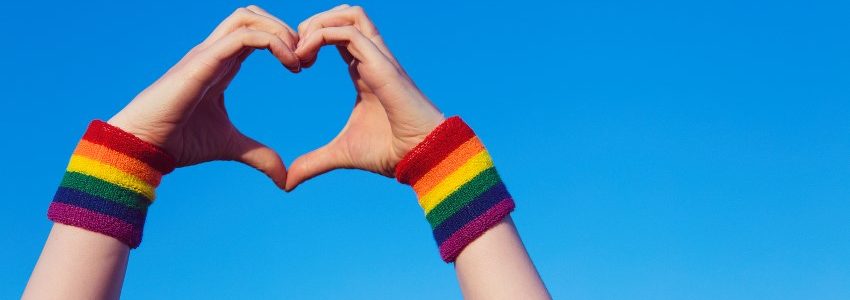We have spent the last few weeks learning and understanding more about the queer community, and how the kink community overlaps and is included under the queer spectrum. Before Pride Month ends, let us take some time to look at the minorities within the minority – the fringe groups within the queer community that are just starting to gain traction in the fight for inclusion and recognition.
The terms LGBTQ+ or LGBTQIAP are the newest, most inclusive acronyms for the queer community. But as we keep adding letters, do we know what is truly meant by them? With so many new terms and definitions for gender identity and sexual orientation, it can be hard to keep up. Broken down, the letters stand for this:

Let us now take this final week of Pride to take a look at our brothers and sisters of the Transgender/Transexual and Asexual/Aromantic communities, and to learn what it means to truly be an Ally.
Transgender/Transexual
Transgender people are those who have a gender identity different from the gender their were assigned at birth. It can take a long time for them to come to terms with their feelings and questions about their own gender identity. It is also common for transgender people to pursue medical gender affirming treatments (hormone therapies and/or surgeries) once they have come to terms with their own identity – this is usually called “transition.” Limitations in health care coverage and poor access to queer friendly medical professionals are some of the biggest challenges facing trans people in being able to live their lives as their true gender. Mismatch of physical appearance with a trans person’s true gender leads to increased instances of discrimination and harrassment, and higher rates of depression and suicide in trans persons.
“Coming out” for a trans person can be different than for cisgender persons. For most members of the queer community, being out is a goal to be reached – to shed the fear and shame associated with being LGB. However, for trans people, many would prefer to “pass” as their true identity, not be seen as a gender that they do not feel is theirs. Make sure to always ask before “outing” a trans person – many are very private and selective about who they share their history with.
It is also important to recognize that trans people can have any type of sexual orientation. For example, someone assigned male at birth (AMAB), who transitions to their true gender of female (MtF), is considered a lesbian if she is sexually attracted to other women. Similarly, a trans male – assigned female at birth (AFAB) – that has not yet undergone gender affirming surgery, and has a male partner is still considered a gay male.
Additionally, Non-Binary people are considered part of the trans population. NB people are those that identify as both male and female (genderfluid or genderqueer), or as something “other” than either of those. Gender identity and sexual orientation are two different things and it is important to respect each person’s definition of their own sexuality.
Asexual/Aromantic
Asexual persons (or “Aces”) are those that have little or no feelings of sexual attraction. Just like trans persons, asexual people can also identify with a sexual (or in this case, romantic) orientation – so a male who is asexual but has a romantic attraction to women is hetero-romantic. There are many misconceptions about asexuality – that asexual people are celibate, that they are incapable of orgasming, that they cannot form actual romantic bonds with others, etc. Asexual people can suffer from depression and anxiety just as often as other members of the queer community due to feelings of being “abnormal” or inadequacy because of a lower libido.
On the other end of the spectrum are Aromantic persons (or “Aros”), who do not experience romantic attraction to others. Being aromantic does not mean that they cannot experience love or form significant bonds with family, friends, or sexual partners. It can be harder for Aros to realize their sexual identities because they experience sexual attraction – often they are accused of being “commitment phobic” or simply stigmatized as “sluts” for being able to be sexually involved without romantic involvement.
It is possible for someone to be asexual and aromantic as well. Both groups are often unrepresented and have been considered the “invisible orientations.” It is important that we try to bring recognition and understanding to members of these groups, just as much as any other members of the queer community.
Another group often left out of other orientation discussions are Pansexual persons – mistakenly lumped together with bisexuality. To be pansexual is to be attracted to an individual, not a gender – to find males, females, non-binary, transexual, and intersex persons sexually and/or romantically attractive. This group is generally the most inclusive orientation, though each person may define who and what they are attracted to differently.
Ally Activism
Ally is the general term used to identify cis-gendered, heterosexual people who advocate and defend the queer community – to support equal civil rights, gender equality, and challenge discrimination on the basis of sexual orientation or gender. Being an Ally does not require you to be an expert in LGBTQ+ issues – simply educating yourself on topics related to gender identity and sexual orientation, and supporting LGBTQ+ organizations are ways that you can demonstrate your support for the queer community. Take it upon yourself to stop homophobic/transphobic jokes and remarks around. Lead by example at your workplace or church group or social events – be welcoming to queer persons, encourage the use of inclusive language, have conversations to better understand other people’s perspectives. Be the person that someone feels comfortable coming out to, and help them figure out how to come out to others (if they are ready).
Allies turn “them” into “us,” allowing LGBTQ+ persons to be themselves, and supporting them in their journeys of identity discovery and self-expression.
In Closing
We hope that this Pride you have had time to learn, to reflect, and to make connections with the queer community. The month of June may be dedicated to Pride, but LGBTQ+ equality is an ongoing struggle around the world. If you are queer or questioning currently, we hope that you have found the words to help define yourself, to realize that you are not alone on your journey. Continue educating yourself on queer issues, get to know your brothers and sisters within the kink communities, decide the type of Ally you want to be.
“Love and Compassion are necessities, not luxuries. Without them, humanity cannot survive.” – Dalai Lama
These educational topics wouldn’t be possible without the hard work and dedication from our Dom(me)sLife contributors – Thank you MM
Contributors: This article was researched and written by sweetdebauchery, edited by Mistress Michelle and published by Umlindi.
